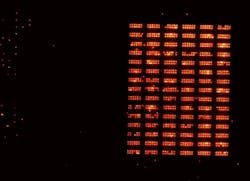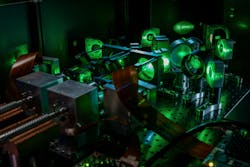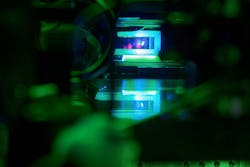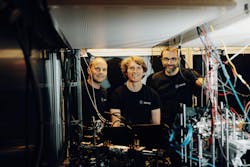Continuously operated quantum registers with neutral atoms
Systems of many interacting quantum particles feature a remarkably rich phenomenology due to the complex interplay between their constituents. Examples include the collective behavior found in low-dimensional quantum magnets or the emergence of exotic superfluids. To understand such phenomena, physical sciences resort to classical simulations of their underlying models. While these classical simulations made big strides explaining various phenomena, for very complex systems, often with dynamics, classical calculations are doomed to fail and exceed the capabilities of today’s most advanced supercomputers. This failure of classical methods to accurately simulate some quantum mechanical systems is due to the exponential scaling of complexity with system size.
At the same time, a fundamental understanding of complex quantum systems is essential for predicting the properties of, for example, certain materials or biomolecules. In the early 1980s, physicist and Nobel Prize laureate Richard Feynman proposed using quantum simulators and computers to calculate complex quantum mechanical phenomena rather than classical computers because they obey the same laws as the systems to be calculated and circumvent the limitations of classical computers.
While quantum simulators are primarily suited to specific, platform-tailored problems, such as in solid-state physics or elementary quantum magnets, digital quantum computers are more universally applicable.
But their additional capabilities come at the cost of increased complexity: creating digital quantum computers requires individually controllable qubits, which are the elementary units for storing and processing quantum data. Interactions between such qubits can be exploited to achieve entanglement, which, together with the superposition of different qubit states, form the basis of the alleged computational power of quantum computers.
The wide range of applications for quantum computers opens up new scientific and technological possibilities, for example, when quantum computers are tightly integrated with classical supercomputers to perform certain, specifically portioned and tailored subtasks more efficiently than their classical counterparts.
Scalability and error correction
A major hurdle to create quantum computers powerful enough to meet these expectations is the scalability of the number of qubits while maintaining single-qubit control. These challenges must be overcome to achieve quantum error correction, which is generally accepted as a prerequisite for building a digital quantum computer.
Neutral atoms confined within individual optical traps are one of several competing approaches to achieving error-corrected quantum computers. In this platform, the qubits are encoded within the internal states of individual atoms. Such an approach to quantum computing is advantageous because individual atoms have no production variability, unlike platforms where qubits are encoded within solid-state systems.
While scalable trapping is possible using optical lattices, which can be thought of as light crystals formed by interfering laser beams, qubit control can be obtained by adding tightly focused laser beams. Together with the ability to read out the state of individual qubits, the platform fulfills all elementary requirements for achieving so-called fault-tolerant quantum computers based on error-corrected logical qubits.
One critical step in the pursuit of error-corrected neutral atom quantum computers is the ability to run neutral-atom experiments continuously. Traditionally, neutral-atom experiments are operated in a mode where the atomic register is cleared after one run and the entire register is reloaded for every new run. Such a mode of operation would be incompatible with scalable error-corrected qubits that may need to run for extended periods of time to tackle some of the applications mentioned above. Therefore, continuous operation is paramount to unlock the potential of quantum computers and simulators based on neutral atoms.
Recycling atoms to create larger-scale registers
In our experiment at the Max Planck Institute of Quantum Optics and in collaboration with the neutral-atom quantum computing startup planqc, our group recently succeeded in maintaining an atomic register in continuous operation. The key to this breakthrough was combining two special trapping regions and the specific internal-level structure of the alkaline earth atom strontium, the species of choice in our experiment.
Using an optical lattice as the storage register and an optical tweezer array as the loading register, we added 130 fresh atoms to the storage register in a cycle—replacing lost atoms in the storage zone.
To enable the reloading, the atoms already present in the storage register were transferred to a metastable triplet state, typically found in alkaline earth and alkaline-earth-like atoms, which enables reloading without significant effect on the atoms already present in the register. Moreover, the ability to retain and reuse existing atoms in the register enables an iterative assembly of larger registers than would be possible otherwise.
The register achieved with this technique reached a size of about 1,200 atoms—nearly an order of magnitude more than the number of atoms loaded in a single cycle. Such a scaling advantage can be directly translated into advantages in applications such as quantum simulation, where larger-scale systems with microscopic control have advantages in terms of reducing the artificial effects in the system due to the boundaries, or in quantum metrology, where the number of atoms in a system translates into the achievable precision with which certain quantities can be measured—for example, frequencies in an atomic clock.
The next steps in this experiment are to control the internal electronic state of the atoms, for example, using optical tweezers, so that each individual atom in the array becomes a qubit holding quantum information. Adding controlled interactions between nearby atoms in the array then enables the generation of quantum entanglement—the basis for any quantum computation and a subject of ongoing research in quantum many-body systems, where it is thought to play an important role in unlocking some of the secrets of complex quantum matter.
FURTHER READING
F. Gyger et al., Phys. Rev. Res., 6, 033104 (Jul. 25, 2024); https://doi.org/10.1103/physrevresearch.6.033104.
About the Author
Johannes Zeiher
Johannes Zeiher is the research group leader at the Max Planck Institute of Quantum Optics and co-founder of quantum computing startup planqc.



